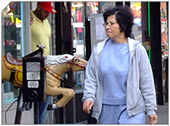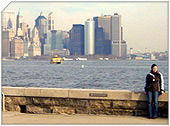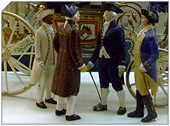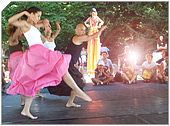Getting Started
Index
NYC Neighborhoods
Manhattan
Brooklyn
Queens
Bronx
Staten Island
NYC Icons
Chrysler Building
Flatiron Building
Empire State Building
Safe NYC
NYPD
FDNY
NYC Weather
NYC Climate
NYC Weather Forecast
Winter Season
Spring Season
Summer Season
Fall Season
NYC History & Politics
New York City History
Tammany Hall and Politics
New York City Politicians
New York City Personalities
Culture of Gotham City
Culture of the city
Cultural diversity
City in popular culture
|
Stanley Kubrick (July 26, 1928 - March 7, 1999) was an influential and acclaimed American film director and producer considered among the greatest of the 20th Century. He directed a number of highly acclaimed and sometimes controversial films, including 2001: A Space Odyssey, Paths of Glory, A Clockwork Orange, Full Metal Jacket, and Dr. Strangelove or: How I Learned to Stop Worrying and Love the Bomb.
Early life
Stanley Kubrick was born on July 26, 1928 at the Lying-In Hospital in Manhattan, the first of two children born to Jacques Leonard Kubrick (1901-1985) and his wife Gertrude (née Perveler; 1903-1985); his sister, Barbara, was born in 1934. Jacques Kubrick, whose parents were Jewish immigrants of Austro-Romanian and Polish origin, was a doctor. At Stanley's birth, the Kubricks lived in an apartment at 2160 Clinton Avenue in The Bronx.
Kubrick's father taught him chess at age twelve; the game remained a life-long obsession. When Stanley was thirteen-years-old, Jacques Kubrick bought him a Graflex camera, triggering Kubrick's fascination with still photography. He also was then interested in jazz, attempting a brief career as a drummer.
Kubrick attended William Howard Taft High School, 1941-1945. He was a poor student with a meager 67 grade average. On graduation from high school in 1945, when soldiers returning from the Second World War crowded colleges, his poor grades eliminated hopes of higher education. Later in life, Kubrick spoke disdainfully of his education and of education in general, maintaining that nothing about school interested him.
In high school, he was chosen official school photographer for a year. Eventually, he sought jobs on his own, and by graduation time had sold a photographic series to Look magazine in NYC. Kubrick supplemented his income playing "chess for quarters" in Washington Square Park and in various Manhattan chess clubs. He registered for night school at the City College to improve his grade-point average. He worked as a freelance photographer for Look, becoming an apprentice photographer in 1946, and later a full-time staff photographer.
During his Look magazine years, on May 29, 1948, Kubrick married Toba Metz (b. 1930) and they lived in Greenwich Village, divorcing in 1951. It was then that Kubrick began frequenting film screenings at the Museum of Modern Art and in the cinemas of New York City. He was particularly inspired by the complex, fluid camera movement of Max Ophüls, whose films influenced Kubrick's later visual style.
Many early-period (1945-1950) photographs by Kubrick were published in the book "Drama and Shadows" (2005, Phaidon Press).
|
New York City Search
Quick NYC
|



 New York Weather Forecast
New York Weather Forecast
 Ethnic composition
Ethnic composition


















